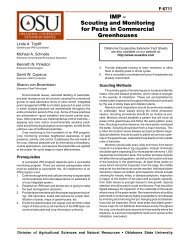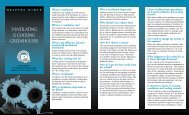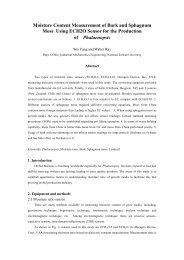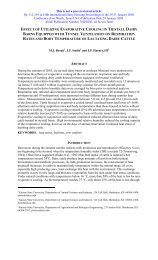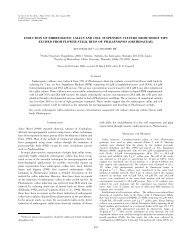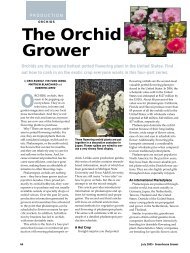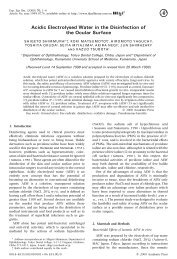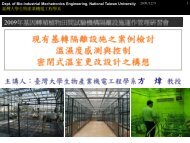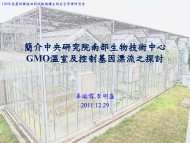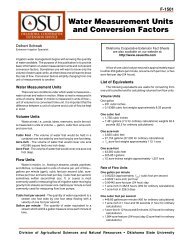58 <strong>CHAPTER</strong> 4Figure 4.10. Simulated results of CUC03 model.The structure of the model is similar to the one in section 4.3. In the presentprogram, there are six unknown variables, TF, T1 - T4, and WF; and 6 equations.TF = f 1 (TF, T1,Wf), T1 = f 2 (TF, T1, T2), T2 = f 3 (T1, T2, T3)T3 = f 4 (T2, T3, T4), T4 = f 5 (T3, T4), WF = f 6 (TF)In the present model shown in Fig. 4.9, the new function FWS in subprogram‘fws.m’ (see Fig. 4.9c) for calculating the saturated humidity ratio is included.This semi-empirical expression calculates saturated humidity ratio (dummyargument is WWW) if a wet-bulb temperature (dummy argument is TTT) is given(after ASHRAE, 1988). Other approximations of the curve are also available withless accuracy (see CUC150).One of the new boundary conditions is dew-point temperature (TD) of the air.Using TD, humidity ratio of the air (WO) as well as atmospheric emissivity (ESPA)are calculated by eq. 4.18. Humidity ratio at the soil surface (WF) is alsocalculated using the function FWS.The results of the model are given in Fig. 4.10. In the present case, the soil isassumed to be completely wet, that is, saturated at the soil surface. Therefore,potential evaporation takes place and cools down the soil surface temperature. Themaximum temperature of the surface is just above 18 o C, which is 5 o C lower than inthe case presented in section 4.3. Deeper soil layers have little effect on thesurface.
<strong>HEAT</strong> <strong>BALANCE</strong> <strong>OF</strong> <strong>BARE</strong> <strong>GROUND</strong> 594.6. RADIATION <strong>BALANCE</strong>Radiation is emitted from a body whose temperature is above 0 K; in the presentsituation, that is, everything emits radiation. Radiation is always considered abalance. For the radiation balance of the bare ground, net radiation is defined as thedifference between incoming radiation from the sky and outgoing radiation from theground. In the daytime, the balance includes solar radiation, of course. The netradiation only for long wave radiation is called effective radiation. In the nighttime,net radiation is equal to effective radiation.Radiation is like light; it can be considered to travel in a straight line. If twobodies, such as the sky and the ground, are placed face to face without anyintermediary, the radiation exchange between these two bodies is one to one. Theheat balance systems we have so far considered are of this type -- that is, the bodiesinvolved are the flat soil surface and the sky. These two surfaces can be consideredinfinite and parallel. Therefore, the radiation emitted from one surface alwaysenters the other.But when another body such as a building is involved, as shown in Fig. 4.11, partof the radiation from the ground cannot go directly to the sky, and vice versa. Thissituation can be visualized by looking at the figure from the direction shown by theword ‘eye’. Suppose the building is infinite in the direction perpendicular to thepage: then half of the sky and half of your perspective are occupied by the face ofthe building. The ground does receive half of the radiation from the sky, but it alsoreceives half of that from the building surface. In this case, it is said that the viewfactor of the ground to the sky is 0.5 and the view factor of the ground to thebuilding is 0.5. On the other hand, if you move your eye from the ground to thebuilding surface, it is clear that the view factor of the building to the sky is 0.5. Ofthe three items being discussed, normally the sky has the lowest temperature and thesmallest amount of long wave radiation. On calm clear nights, the soil surface iscooled by radiation because of this fact. However, if half of the sky is blocked by alarge building such as shown in Fig. 4.11, the soil surface will be warmer becausemore radiation will travel from the building surface to the soil surface. Therefore,it is very important to take into account view factor relations when we analyzeradiation exchange among surfaces of different surface temperatures.View factor takes into consideration the area of another body with which theradiation exchange takes place in relation to the total hemisphere of the exchangesurface. This relationship is three-dimensional, and the geometric relationshipbetween the two bodies is not simple. A simple way to calculate the view factor isto project all the areas onto the horizontal surface with which the basic surface isinvolved; then the hemisphere becomes the unit circle and the projected area of thebody is the view factor, as shown in Fig. 4.12. The important relationship is that



